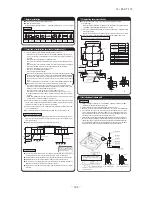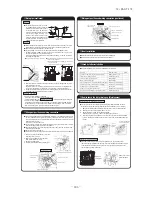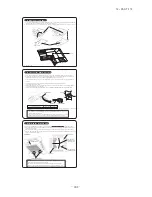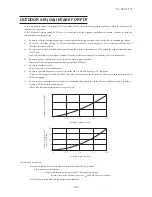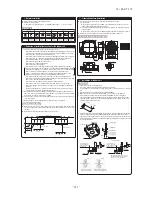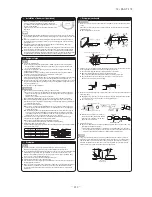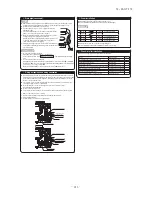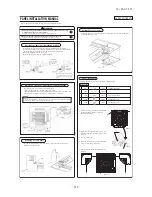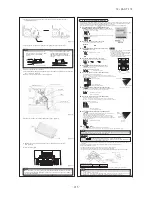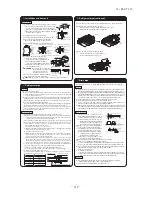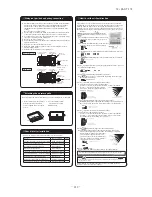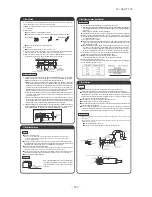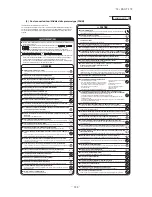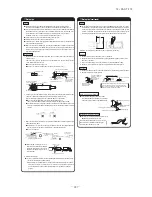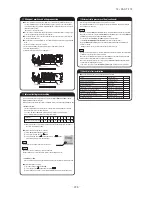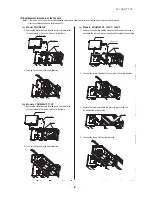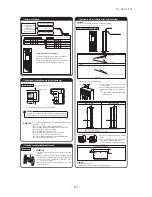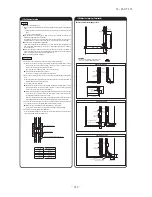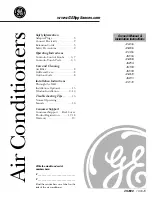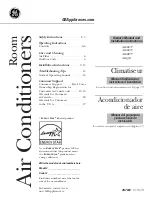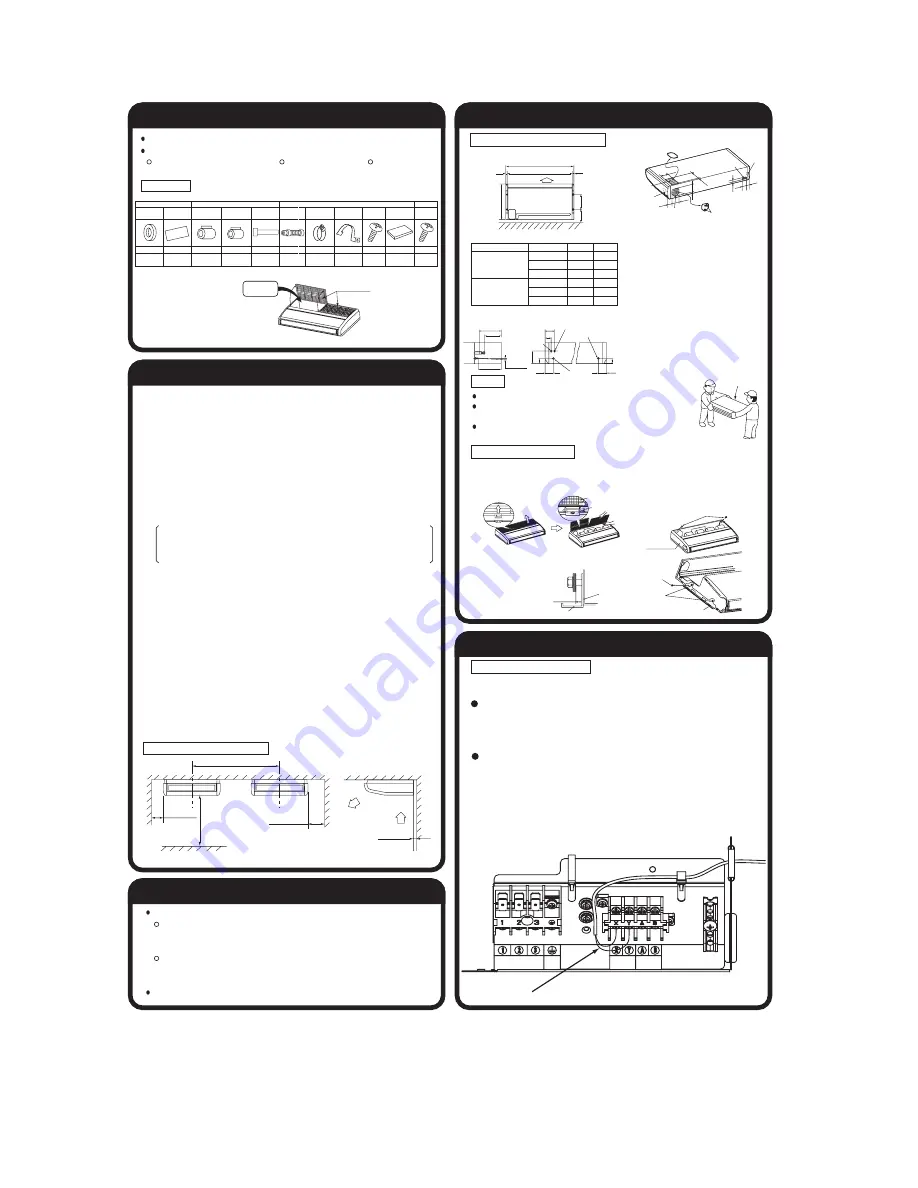
-
217
-
'12 • PAC-T-173
Air return grille
Accessories
are inside.
235(Liquid piping)
195(Gas piping)
271
110
76
135
75
10
109
53
53
Unit interior
10 mm slope
Gas
piping
Liquid
piping
Refrigerant line
Drain piping
(right)
Drain piping (left)
Blowout opening
Wall
215
290
690
24
24
B
A
60
100
60
47
120
175
19
27
31
27
108
Right outlet
Top outlet
Rear outlet
Rear cover
Cutout parts
Top cover
Drain line
(left)
Drain line
(rear left)
Grille upside
(Indoor unit)
Filter
Pin
Side panel screw
(1 each on the left and right) (M4)
Side panel
Indoor
unit
Hanging plate
Unscrew
8-12mm
Hanging plate
screw
Hanging
plate fixing
bolts(M8)
Hanging plate
4000~5000mm or more
100mm
or more
300mm or mor
e
150mm or more
5mm or more
Obstacle
Remove the line
Location of pipe outlets
Pipe position
Pitch of suspension bolts
̪
The outlet through which the pipings are taken out is
available in three directions.
̪
Pipes can be taken out in 3 directions (rear, right or
top).
Cut out holes using nippers, etc.
Cut out holes to take out pipes along the cutoff line
on the rear cover.
Cut out the top face cover aligning to the piping
position.
When taking pipe out to right-hand side, cut out a
hole along the groove at the inside of side panel.
After installing pipes and wires, seal clearances
around pipes and wires with putty, etc. to shut off
dust.
Make sure to install the covers at rear and top in order to
protect the inside of unit from intrusion of dust or
protect wires from damages by sharp edges. When
taking them out to the right-hand side, remove burrs or
sharp edges from the cutout.
①
Before installation
③
Preparation before installation (continued)
②
Selection of installation location for the indoor unit
Accessory item
For unit hanging
For refrigerant pipe
Flat washer (M10) Paper pattern Pipe cover (large) Pipe cover (small)
Strap
8
1
1
1
4
For unit hanging
For heat insulation
of gas pipe
For heat insulation
of liquid pipe
For fixing of pipe
cover
For unit hanging
and adjustment
①
Select the suitable areas to install the unit under approval of the user.
Areas where the indoor unit can deliver hot and cold wind sufficiently.
Suggest to the user to use a circulator if the ceiling height is over 3m to
avoid warm air being accumulated on the ceiling.
Areas where there is enough space to install and service.
Areas where it can be drained properly. Areas where drain pipe descend-
ing slope can be taken.
Areas where there is no obstruction of airflow on both air return grille and air supply port.
Areas where fire alarm will not be accidentally activated by the air conditioner.
Areas where the supply air does not short-circuit.
Areas where it is not influenced by draft air.
Areas not exposed to direct sunlight.
Areas where dew point is lower than around 23°C and relative humidity is lower than 80%.
This indoor unit is tested under the condition of JIS (Japan Industrial
Standard) high humidity condition and confirmed there is no problem.
However, there is some risk of condensation drop if the air conditioner is
operated under the severer condition than mentioned above.
Areas where TV and radio stays away more than 1m. (It could cause jamming and noise.)
Areas where any items which will be damaged by getting wet are not placed
such as food, table wares, server, or medical equipment under the unit.
Areas where there is no influence by the heat which cookware generates.
Areas where not exposed to oil mist, powder and/or steam directly such as above fryer.
Areas where lighting device such as fluorescent light or incandescent light
doesn’t affect the operation.
(A beam from lighting device sometimes affects the infrared receiver for the
wireless remote controller and the air conditioner might not work properly.)
②
Check if the place where the air conditioner is installed can hold the weight of the unit.
If it is not able to hold, reinforce the structure with boards and beams strong enough
to hold it. If the strength is not enough, it could cause injury due to unit falling.
③
If there are 2 units of wireless type, keep them away for more than 6m to
avoid malfunction due to cross communication.
④
When plural indoor units are installed nearby, keep them away for more than 4 to 5m.
③
Preparation before installation
Pitch of suspension bolts and pipe position
1. Remove the air return grille.
Slide stoppers (4 places) of the catches,
then pull out the pins ( 4 or 6 places).
3. Remove the hanging plate.
Remove the screw, and then loosen
the fixing bolts.
2. Remove the side panel.
Remove the screw and detach the
side panel by sliding it toward the
direction indicated by the arrow mark.
Move the box as close to the installation area as possible packed.
If it must be unpacked, wrap the unit with a nylon sling,
and be careful not to damage the unit.
If you need to lay the unit on a floor after unpacking, always
put it with the intake grille facing upward.
Series
type
A
B
40 to 50type
1070
1022
60 to 71type
1320
1272
100 to 140type
1620
1572
36 to 56type
1070
1022
71type
1320
1272
112 to 140type
1620
1572
Single Split (PAC)
series
VRF (KX) series
For drain pipe
Drain hose
(with clamp)
Hose clamp Fixing bracket
Screw
Heay insulation
1
1
2
1
For drain hose
For drain pipe
connection
For fixing of
drain hose
1
For drain hose
mounting
For installing of
fixing bracket
For air return grille
Screw
4
For fixing air
return grille
Preparation before instalation
④
Remote controller
Installation of remote controller
Up to two receiver or wired remote controller can be installed in one indoor unit
group.
Space for installation and service
Haulage
(mm)
Install correctly according to the installation manual.
Confirm the following points:
Unit type/Power supply specification Pipes/Wires/Small parts Accessory items
If suspension bolt becomes longer, do reinforcement of earthquake resistant.
For grid ceiling
When suspension bolt length is over 500mm, or the gap between the ceiling
and roof is over 700mm, apply earthquake resistant brace to the bolt.
In case the unit is hanged directly from the slab and is installed on the
ceiling plane which has enough strength.
When suspension bolt length is over 1000mm, apply the earthquake resistant brace to the bolt.
Prepare four (4) sets of suspension bolt, nut and spring washer (M10) on site.
When both wired and wireless remote controller are used
It is necessary to set wired or wireless remote controller as slave.
(For the method of changing the setting, refer to the installtion
manual attached to remote controller or wireless kit.)
When wired remote controller are used only (wireless type)
It is necessary to remove the line that is connected to the receiver.
Remove signal line connected to the receiver from primary side of
terminal block (X, Y).
ATTENTION
①
Insulate with tape the removed line.
②
The LED of that removed connector will not be able to make any
indication.
Summary of Contents for FDC Series
Page 95: ... 94 12 PAC T 173 Models FDT100VF 125VF 140VF H H H H H C B A F G D G PJF000Z285 ...
Page 98: ... 97 12 PAC T 173 Models FDEN60VF 71VF C 2 C 1 A B A B D C 1 C 2 C 1 C 2 E G F B PFA003Z817 ...
Page 113: ... 112 12 PAC T 173 b Wireless remote controller RCN E1R 60 17 150 Unit mm ...
Page 278: ... 277 12 PAC T 173 ー K ...
Page 346: ... 345 12 PAC T 173 Power PCB 1BSU OVNCFS 4GRNCEG VJG 2 ...
Page 518: ... 517 12 PAC T 173 3 5 SUPER LINK E BOARD SC ADNA E F SL2NA E and SL3N AE BE to control ...
Page 519: ... 518 12 PAC T 173 ...


